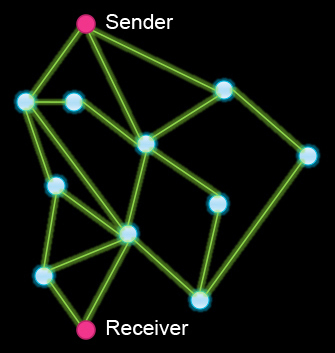Network Redundancy
On this page, you will learn how the layout of the Internet is redundant (more than one path from here to there) in order to ensure reliability.
CSN-1.B.5, CSN-1.B.7, CSN-1.E.3, CSN-1.E.4, CSN-1.E.5, CSN-1.E.6, CSN-1.E.7
:
Path,
Routing,
Scalability,
Redundancy, and
Fault tolerance
CSN-1.A.5, CSN-1.A.6, CSN-1.B.6, CSN-1.E.2, CSN-1.E.5
- A path is a sequence of directly connected computing devices that connect a sender to a receiver.
- Routing is the process of finding a path from sender to receiver.
- Scalability is the ability of the Internet to keep working as it grows.
- Redundancy is the inclusion of back-up elements in case one part fails.
- Fault tolerance is the ability of a system to work around problems.

Thomas (David) Petite (born 1956) is a member of the Fond du Lac Band of the Lake Superior Chippewa tribe. David is best known for his work on wireless enabled devices. He is one of the early inventors of the wireless ad hoc networks, a temporary decentralized type of wireless network that enables all mobile phones to work today. His inventions were also a driving force behind the development of what is now known as the "Smart Grid" which monitors and harnesses the power of wireless-enabled devices at a specific location.
Learn More
Given the enormous number of devices on the Internet and the reality that pieces of a complex system fail at unexpected times (and often in groups of neighbors such as a whole city), the Internet had to be designed to be reliable. This is achieved by building many redundant connections into the physical systems of the Internet. That way, if part of the Internet fails, data can be re-routed via a different path. And such changes to the path can happen in transit because routing on the Internet is dynamic; it is not specified in advance. Creating such redundancy can require additional resources (such as additional computers and cables) but it also increases the Internet's fault tolerance (ability to work around problems) and helps the Internet scale (expand) to more devices and people.
-
 Describe what's going on in this animation.
Describe what's going on in this animation.
Someone should follow-up with Dan about where these images came from. --MF, 8/29/19

In the animation, a lightening bolt strikes one of the nodes. There are many reasons a node can fail, such as power failure, chip burnout, etc. The other thing that can happen is that the nodes can all be fine, but the green lines linking the nodes, which represent connections, could fail (e.g., a cable could be cut or disconnected, either accidentally or on purpose).
-

In this model of a network, what is the
minimum number of nodes (connection points) that can stop working before the sender and the receiver can't communicate? (Other than the sender or the receiver themselves, of course.)
1
There are no nodes that are vital to the system. Pick any node to stop working, and you can still find another path.
2
Correct! If the node with six connections goes down and also either of the two to its left, the sender and receiver can't communicate.
3
Try to find a smaller number of nodes that can stop working and still break communication.
4
Try to find a smaller number of nodes that can stop working and still break communication.
5
Try to find a smaller number of nodes that can stop working and still break communication.

In the same model network, what is the
maximum number of nodes that can fail and still let Sender and Receiver communicate?
10
Draw a path from sender to receiver that still works.
9
Draw a path from sender to receiver that still works.
8
Correct! If the four nodes on the right and also the four nodes on the left all fail, the remaining two nodes in the middle will still allow the sender and receiver to communicate.
7
Try to find a higher number of nodes that can stop working and still permit communication.
6
Try to find a higher number of nodes that can stop working and still permit communication.
-
CSN-1.E


- Describe the benefits of fault tolerance. What kind of problems could arise with the connection of millions of devices across the planet that make it necessary for the Internet to be fault-tolerant?
- What feature(s) of the Internet makes it fault-tolerant?
- In what ways can the Internet fail?


 In this model of a network, what is the minimum number of nodes (connection points) that can stop working before the sender and the receiver can't communicate? (Other than the sender or the receiver themselves, of course.)
In this model of a network, what is the minimum number of nodes (connection points) that can stop working before the sender and the receiver can't communicate? (Other than the sender or the receiver themselves, of course.)